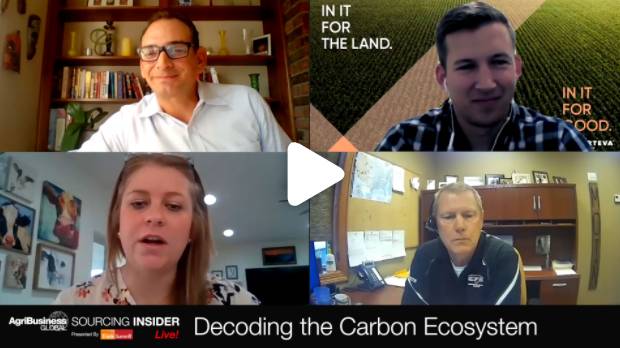Empowering the Channel to Monetize Carbon: 4 Key Takeaways from AgriBusiness Global Live Event
AgriBusiness Global hosted an Executive Outlook Live! event in mid-October, “Empowering the Channel to Monetize Carbon.” Editor David Frabotta sat down with panelists Ben Gordon, portfolio leader for carbon ecosystem services at Corteva Agriscience; Mariah Murphy, senior manager of member owner engagement at Truterra; Don Harberts, vice president of agronomy at Cooperative Farmers Elevator to discuss issues surrounding the carbon green rush, including how and when to engage in this emerging marketplace. Industry estimates say just 3% producers are engaged in a carbon farming program. Panelists sought to clarify confusion and share perspectives on what it will take for more widespread of adoption of carbon programs.
1. Carbon is no fad. It’s here to stay, so lean in, and prepare for the long-term. Confusion reigns throughout the ag industry about what the carbon market is and how to distinguish different programs, much less decide on one. But you aren’t going to learn from the sidelines.
“We might not like (the carbon market) today or be convinced of its benefits, but let’s prepare for one, three, and five years down the road,” Harberts said. “That’s our job as a retailer to drive through the confusion and make sure we’re driving the correct message.”
The biggest questions Harberts gets from producers revolve around the risks and rewards of investing in and implementing various carbon practices. A fully realized carbon market is “not going to happen overnight,” he said. “We always tell our team to begin with the end in mind. This is a shift in the thinking process: We can’t look at it as a one-year investment but a multiple-year process and communicating with our growers.” To that end, more time needs to be spent in preparation for a carbon market where growers can realize greater returns on their investment (e.g., $25 or $30/ton) than they can today.
“As a cooperative that touches 4,000 growers, our role is to take lots of information out there, deliver it to growers and clear up as much confusion as we possibly can,” he added. The carbon market will continue to present a large opportunity for growers, and his cooperative will continue to work with Bayer, Corteva, Land O’Lakes, and others. By bringing information to growers, they will reap benefits maybe not today or this year, but somewhere down the road.
2. Avoid dwelling on minutiae. It’s easy to get overwhelmed and leave money on the table. Too many people dwell on the length of carbon program contracts and ambiguity in the marketplace to their detriment, Murphy and other panelists said.

View “Empowering the Distribution Channel to Monetize Carbon” on demand here.
“There is a lot of concern and very real anxiety about getting burned in the contract, but it’s not necessarily accurate,” Murphy said. “They’re really leaving money on the table. These large corporations are going to invest the money in some way to reduce greenhouse gas emissions,” she said, so, “It’s important that we as an agricultural community stand together and be willing and able to help them. This is less about growers investing but more so about us strengthening our rural economies and our farming operations and allowing us to take advantage of that money that they’re bringing to us.”
Gordon acknowledged that becoming overwhelmed is very easy. At the end of the day, make sure your agronomics are right and recognize this: “All we’re doing is juicing the business case for environmentally friendly practices and building the option value for farmers to have a net new revenue stream that could grow and grow.” He stressed that participating in a carbon program is “really just an extension of your existing business. You are not going to learn from the sidelines.”
3. Stay on point with your agronomic decisions. “We always say, start with agronomy, then do the agronomy second, then third, and if that all makes sense now let’s talk carbon programs,” Gordon stressed. For his team at Bayer, this means offering digital tools to simplify carbon program access, having a field team that can support sellers as well as trusted advisers to focus on the agronomy to help provide access to multiple types of carbon programs.
4. Improvements in carbon sequestration and data collection are key. “I get excited about uncertainty bars coming down so we’re able to give the full credit to farmers for soil, but the area that gets me most excited is nitrogen,” Gordon said. “There is so much potential around nitrogen and it fits this whole story of ROI.”
While it’s a tougher case to make system-level changes like tillage or cover cropping or inputs, when it comes to nitrogen, “folks are tweaking that already,” he adds. “If we can bring those uncertainty bars down so we can pay more for those reductions or better utilization of nitrogen – all your classic 4Rs – that’s where I see technology unlocking a lot more for the industry.”
Murphy noted that 114 data points are currently collected, and that will be pared down as the market evolves. She called attention to the need for baselines of data to fully develop outcomes and the carbon market. Right now, capturing and collecting data is a decidedly manual process; however, companies are working toward more automated solutions.
“We all know that not every farmer is at the same stage in their digital journey,” Gordon said. “Now that we’re finally paying farmers for environmental outcomes, now how can we help them with agronomic choices? There’s an opportunity to optimize fertility plans and seed selection. Carbon is just a layer on top of farmers’ and the channel’s existing businesses.”






